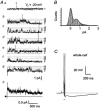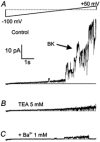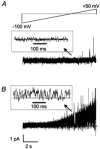TEA- and apamin-resistant K(Ca) channels in guinea-pig myenteric neurons: slow AHP channels
- PMID: 11790810
- PMCID: PMC2290069
- DOI: 10.1113/jphysiol.2001.012952
TEA- and apamin-resistant K(Ca) channels in guinea-pig myenteric neurons: slow AHP channels
Abstract
The patch-clamp technique was used to record from intact ganglia of the guinea-pig duodenum in order to characterize the K(+) channels that underlie the slow afterhyperpolarization (slow AHP) of myenteric neurons. Cell-attached patch recordings from slow AHP-generating (AH) neurons revealed an increased open probability (P(o)) of TEA-resistant K(+) channels following action potentials. The P(o) increased from < 0.06 before action potentials to 0.33 in the 2 s following action potential firing. The ensemble averaged current had a similar time course to the current underlying the slow AHP. TEA- and apamin-resistant Ca(2+)-activated K(+) (K(Ca)) channels were present in inside-out patches excised from AH neurons. The P(o) of these channels increased from < 0.03 to approximately 0.5 upon increasing cytoplasmic [Ca(2+)] from < 10 nM to either 500 nM or 10 microM. P(o) was insensitive to changes in transpatch potential. The unitary conductance of these TEA- and apamin-resistant K(Ca) channels measured approximately 60 pS under symmetric K(+) concentrations between -60 mV and +60 mV, but decreased outside this range. Under asymmetrical [K(+)], the open channel current showed outward rectification and had a limiting slope conductance of about 40 pS. Activation of the TEA- and apamin-resistant K(Ca) channels by internal Ca(2+) in excised patches was not reversed by washing out the Ca(2+)-containing solution and replacing it with nominally Ca(2+)-free physiological solution. Kinetic analysis of the single channel recordings of the TEA- and apamin-resistant K(Ca) channels was consistent with their having a single open state of about 2 ms (open dwell time distribution was fitted with a single exponential) and at least two closed states (two exponential functions were required to adequately fit the closed dwell time distribution). The Ca(2+) dependence of the activation of TEA- and apamin-resistant K(Ca) channels resides in the long-lived closed state which decreased from > 100 ms in the absence of Ca(2+) to about 7 ms in the presence of submicromolar cytoplasmic Ca(2+). The Ca(2+)-insensitive closed dwell time had a time constant of about 1 ms. We propose that these small-to-intermediate conductance TEA- and apamin-resistant Ca(2+)-activated K(+) channels are the channels that are primarily responsible for the slow AHP in myenteric AH neurons.
Figures









Similar articles
-
Afterhyperpolarization current in myenteric neurons of the guinea pig duodenum.J Neurophysiol. 2001 May;85(5):1941-51. doi: 10.1152/jn.2001.85.5.1941. J Neurophysiol. 2001. PMID: 11353011
-
Regulation of K+ channels underlying the slow afterhyperpolarization in enteric afterhyperpolarization-generating myenteric neurons: role of calcium and phosphorylation.Clin Exp Pharmacol Physiol. 2002 Oct;29(10):935-43. doi: 10.1046/j.1440-1681.2002.03755.x. Clin Exp Pharmacol Physiol. 2002. PMID: 12207575 Review.
-
Diversity of channels involved in Ca(2+) activation of K(+) channels during the prolonged AHP in guinea-pig sympathetic neurons.J Neurophysiol. 2000 Sep;84(3):1346-54. doi: 10.1152/jn.2000.84.3.1346. J Neurophysiol. 2000. PMID: 10980007
-
Characteristics of multiple Ca(2+)-activated K+ channels in acutely dissociated chick ciliary-ganglion neurones.J Physiol. 1991 Nov;443:601-27. doi: 10.1113/jphysiol.1991.sp018854. J Physiol. 1991. PMID: 1822541 Free PMC article.
-
Small-conductance calcium-activated potassium channels.Ann N Y Acad Sci. 1999 Apr 30;868:370-8. doi: 10.1111/j.1749-6632.1999.tb11298.x. Ann N Y Acad Sci. 1999. PMID: 10414306 Review.
Cited by
-
Assessing the role of IKCa channels in generating the sAHP of CA1 hippocampal pyramidal cells.Channels (Austin). 2016 Jul 3;10(4):313-9. doi: 10.1080/19336950.2016.1161988. Epub 2016 Mar 7. Channels (Austin). 2016. PMID: 26950800 Free PMC article.
-
Morphological and functional changes in guinea-pig neurons projecting to the ileal mucosa at early stages after inflammatory damage.J Physiol. 2011 Jan 15;589(Pt 2):325-39. doi: 10.1113/jphysiol.2010.197707. Epub 2010 Nov 22. J Physiol. 2011. PMID: 21098001 Free PMC article.
-
A novel calcium-sensitive potassium conductance is coupled to P2X3 subunit containing receptors in myenteric neurons of guinea pig ileum.Neurogastroenterol Motil. 2007 Nov;19(11):912-22. doi: 10.1111/j.1365-2982.2007.00952.x. Epub 2007 Jul 18. Neurogastroenterol Motil. 2007. PMID: 17973642 Free PMC article.
-
Phenotypic changes of morphologically identified guinea-pig myenteric neurons following intestinal inflammation.J Physiol. 2007 Sep 1;583(Pt 2):593-609. doi: 10.1113/jphysiol.2007.135947. Epub 2007 Jul 5. J Physiol. 2007. PMID: 17615102 Free PMC article.
-
Mitochondrial Ca2+ uptake regulates the excitability of myenteric neurons.J Neurosci. 2002 Aug 15;22(16):6962-71. doi: 10.1523/JNEUROSCI.22-16-06962.2002. J Neurosci. 2002. PMID: 12177194 Free PMC article.
References
-
- Bekkers JM. Distribution of slow AHP channels on hippocampal CA1 pyramidal neurons. Journal of Neurophysiology. 2000;83:1756–1759. - PubMed
-
- Bertrand PP, Kunze WA A, Bornstein JC, Furness JB. Electrical mapping of the projections of intrinsic primary afferent neurons to the mucosa of the guinea-pig small intestine. Neurogastroenterology. 1998;10:533–541. - PubMed
-
- Bond CT, Maylie J, Adelman JP. Small-conductance calcium-activated potassium channels. Annals of the New York Academy of Sciences. 1999;868:370–378. - PubMed
Publication types
MeSH terms
Substances
LinkOut - more resources
Full Text Sources
Miscellaneous

